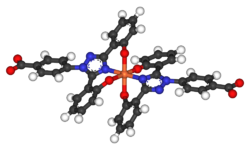Chelation therapy
Chelation Therapy
Chelation therapy is a medical procedure that involves the administration of chelating agents to remove heavy metals from the body. Chelating agents are substances that can bind to metals in the body, forming a stable complex that can be excreted. This therapy is used in the treatment of heavy metal poisoning, such as lead or mercury poisoning, and in conditions like iron overload.
Mechanism of Action
Chelation therapy works by introducing chelating agents into the bloodstream. These agents have a high affinity for metal ions and form stable complexes with them. Once bound, the metal-chelate complex is more water-soluble and can be excreted through the kidneys or gastrointestinal tract.
Common Chelating Agents
Several chelating agents are used in medical practice, each with specific affinities for different metals:
- EDTA: Commonly used for lead poisoning.
- Dimercaprol: Used for arsenic, gold, and mercury poisoning.
- Deferoxamine: Used for iron overload, particularly in patients with thalassemia.
- Deferasirox: An oral chelator used for chronic iron overload due to blood transfusions.
Applications
Chelation therapy is primarily used in the following conditions:
- Heavy Metal Poisoning: Acute or chronic exposure to metals like lead, mercury, arsenic, and cadmium.
- Iron Overload Disorders: Conditions such as thalassemia and sickle cell disease where repeated blood transfusions lead to excess iron accumulation.
- Wilson's Disease: A genetic disorder leading to copper accumulation, treated with chelators like penicillamine.
Controversial Uses
Chelation therapy has been controversially used for other conditions, such as cardiovascular disease, although there is limited scientific evidence supporting its efficacy in these cases. The use of chelation therapy for such purposes is not widely endorsed by medical authorities.
Side Effects and Risks
While chelation therapy can be effective, it is not without risks. Potential side effects include:
- Kidney damage
- Hypocalcemia
- Allergic reactions
- Gastrointestinal disturbances
Related Pages
Transform your life with W8MD's budget GLP-1 injections from $125.
W8MD offers a medical weight loss program to lose weight in Philadelphia. Our physician-supervised medical weight loss provides:
- Most insurances accepted or discounted self-pay rates. We will obtain insurance prior authorizations if needed.
- Generic GLP1 weight loss injections from $125 for the starting dose.
- Also offer prescription weight loss medications including Phentermine, Qsymia, Diethylpropion, Contrave etc.
NYC weight loss doctor appointments
Start your NYC weight loss journey today at our NYC medical weight loss and Philadelphia medical weight loss clinics.
- Call 718-946-5500 to lose weight in NYC or for medical weight loss in Philadelphia 215-676-2334.
- Tags:NYC medical weight loss, Philadelphia lose weight Zepbound NYC, Budget GLP1 weight loss injections, Wegovy Philadelphia, Wegovy NYC, Philadelphia medical weight loss, Brookly weight loss and Wegovy NYC
|
WikiMD's Wellness Encyclopedia |
| Let Food Be Thy Medicine Medicine Thy Food - Hippocrates |
Medical Disclaimer: WikiMD is not a substitute for professional medical advice. The information on WikiMD is provided as an information resource only, may be incorrect, outdated or misleading, and is not to be used or relied on for any diagnostic or treatment purposes. Please consult your health care provider before making any healthcare decisions or for guidance about a specific medical condition. WikiMD expressly disclaims responsibility, and shall have no liability, for any damages, loss, injury, or liability whatsoever suffered as a result of your reliance on the information contained in this site. By visiting this site you agree to the foregoing terms and conditions, which may from time to time be changed or supplemented by WikiMD. If you do not agree to the foregoing terms and conditions, you should not enter or use this site. See full disclaimer.
Credits:Most images are courtesy of Wikimedia commons, and templates, categories Wikipedia, licensed under CC BY SA or similar.
Translate this page: - East Asian
中文,
日本,
한국어,
South Asian
हिन्दी,
தமிழ்,
తెలుగు,
Urdu,
ಕನ್ನಡ,
Southeast Asian
Indonesian,
Vietnamese,
Thai,
မြန်မာဘာသာ,
বাংলা
European
español,
Deutsch,
français,
Greek,
português do Brasil,
polski,
română,
русский,
Nederlands,
norsk,
svenska,
suomi,
Italian
Middle Eastern & African
عربى,
Turkish,
Persian,
Hebrew,
Afrikaans,
isiZulu,
Kiswahili,
Other
Bulgarian,
Hungarian,
Czech,
Swedish,
മലയാളം,
मराठी,
ਪੰਜਾਬੀ,
ગુજરાતી,
Portuguese,
Ukrainian
Contributors: Prab R. Tumpati, MD

